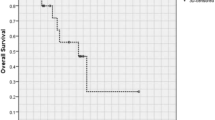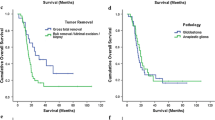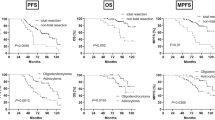Abstract
Purpose
The appropriate management of low-grade gliomas is still a matter of debate. So far, there are no randomized studies that analyze the impact of surgical resection on patient outcome. The value of the data obtained from the few retrospective reports available is often limited.
Patients and methods
In the present study, we performed an analysis on data of 130 adult low-grade glioma patients. Extent of the resection was evaluated in correlation to the overall survival (OS) and progression-free survival (PFS) using Cox regression multivariate analysis.
Results
Extended surgery was shown to prolong OS and PFS significantly. Re-surgery in the case of a tumor relapse has a significant impact on OS and PFS, too.
Conclusions
In summary, we could retrospectively evaluate a large case series of well-defined low-grade gliomas patients with a long follow-up period showing that extended surgery would be the most effective therapy for low-grade glioma patients even in recurrent diseases.


Similar content being viewed by others
References
Albert FK, Forsting M, Sartor K, Adams HP, Kunze S (1994) Early postoperative magnetic resonance imaging after resection of malignant glioma: objective evaluation of residual tumor and its influence on regrowth and prognosis. Neurosurgery 34:45–60. doi:10.1097/00006123-199401000-00008
Claus EB, Horlacher A, Hsu L, Schwartz RB, Dello-Iacono D, Talos F, Jolesz FA, Black PM (2005) Survival rates in patients with low-grade glioma after intraoperative magnetic resonance image guidance. Cancer 103:1227–1233. doi:10.1002/cncr.20867
Duffau H, Lopes M, Arthuis F, Bitar A, Sichez JP, Van Effenterre R, Capelle L (2005) Contribution of intraoperative electrical stimulations in surgery of low-grade gliomas: Contribution of intraoperative electrical stimulations in surgery of low-grade gliomas: a comparative study between two series without (1985–96) and with (1996–2003) functional mapping in the same institution. J Neurol Neurosurg Psychiatry 76:845–851. doi:10.1136/jnnp. 2004.048520
Eyre HJ, Crowley JJ, Townsend JJ, Eltringham JR, Morantz RA, Schulman SF, Quagliana JM, al-Sarraf M (1993) A randomized trial of radiotherapy versus radiotherapy plus CCNU for incompletely resected low-grade gliomas: a Southwest Oncology Group study. J Neurosurg 78:909–914
Guthrie BL, Laws ER Jr (1990) Supratentorial low-grade gliomas. Neurosurg Clin N Am 1:37–48
Henderson KH, Shaw EG (2001) Randomized trials of radiation therapy in adult low-grade gliomas. Semin Radiat Oncol 11:145–151. doi:10.1053/srao.2001.21424
Jeremic B, Bamberg M (2001) Radiation therapy for incompletely resected supratentorial low-grade glioma in adult. J Neuro-Oncology 55:101–112. doi:10.1023/A:1013333905202
Karim AB, Afra D, Cornu P, Bleehan N, Schraub S, De Witte O, Darcel F, Stenning S, Pierart M, Van Glabbecke M (2002) Randomized trial on the efficacy of radiotherapy for cerebral low-grade glioma in the adult: European Organisation for Research and Treatment of Cancer Study 22845 with the Medical Research Council study BR04: an interim analysis. Int J Radiat Oncol Biol Phys 52:316–324. doi:10.1016/S0360-3016(01)02692-X
Kortmann RD, Jeremic B, Weller M, Lutterbach J, Paulsen F, Bamberg M (2004) Immediate postoperative radiotherapy or "Watch and Wait" in the management of adult low-grade glioma? Strahlenther Onkol 180:408–418
Krouwer HG, Davis RL, Silver P, Prados M (1991) Gemistocytic astrocytomas: a reappraisal. J Neurosurg 74:399–406
Lang FF, Gilbert MR (2006) Diffusely infiltrative low-grade gliomas in adults. J Clin Oncol 24:1236–1245. doi:10.1200/JCO.2005.05.2399
Leighton C, Fischer B, Bauman G, Depiero S, Stitt L, MacDonald D, Cairncross G (1997) Supratentorial low-grade glioma in adults: an analysis of prognostic factors and timing of radiation. J Clin Oncol 15:1294–1301
Nakamura M, Shimada K, Ishida E, Nakase H, Konishi N (2007) Genetic analysis to complement histopathological diagnosis of brain tumors. Histol Histopathol 22:327–335
Okamoto Y, Di Patre PL, Burkhard C, Horstmann S, Jourde B, Fahey M, Schüler D, Probst-Hensch NM, Yasargil MG, Yonekawa Y, Lütolf UM, Kleihues P, Ohgaki H (2994) Population-based study on incidence, survival rates, and genetic alterations of low-grade diffuse astrocytomas and oligodendrogliomas. Acta Neuropathol 108:327–335
Peraud A, Ansari H, Bise K, Reulen HJ (1998) Clinical outcome of supratentorial astrocytoma WHO II. Acta Neurochir (Wien) 140:1213–1222. doi:10.1007/s007010050241
Peraud A, Kreth FW, Wiestler OD, Kleihues P, Reulen HJ (2002) Prognostic impact of TP53 mutations and p53 protein overexpression in supratentorial WHO grade II astrocytomas and oligodendrogliomas. Clin Cancer Res 8:1117–1124
Philippon JH, Clemenceau SH, Fauchon FH, Foncin JF (1993) Supratentorial low-grade astrocytomas in adults. Neurosurgery 32:554–559. doi:10.1097/00006123-199304000-00010
Pignatti F, van den Bent M, Curran D, Debruyne CH, Sylvester R, Therasse P, Afra D, Cornu PH, Bolla M, Vecht CH, Karim A, for the EORTC Brain tumor cooperative group and radiotherapy cooperative group (2002) Prognostic factors for survival in adult patients with cerebral low-grade glioma. J Clin Oncol 20:2076–2084. doi:10.1200/JCO.2002.08.121
Rajan B, Pickuth D, Ashley S, Traish D, Monro P, Elyan S, Brada M (1994) The management of histologically unverified presumed cerebral gliomas with radiotherapy. Int J Radiat Oncol Biol Phys 28:405–413
Schramm J, Blümcke I, Ostertag CB, Schlegel U, Simon M, Lutterbach J (2006) Low-grade gliomas-Current concepts. Zentralbl Neurochir 67:55–66. doi:10.1055/s-2006-933408
Shaw EG, Tatter SB, Lesse GJ, Ellis TL, Stanton CA, Stieber VW (2004) Current controversies in the radiotherapeutic management of adult low-grade glioma. Semin Oncol 31:653–658. doi:10.1053/j.seminoncol.2004.07.007
Shaw EG, Wisoff JH (2002) Prospective clinical trials of intracranial low-glioma in adults and children. Neuro-oncol 5:153–160. doi:10.1215/S1152851702000601
Soffietti R, Chio A, Giordana MT, Vasario E, Schiffer D (1990) Prognostic factors in well-differentiated cerebral astrocytomas in the adult. Neurosurgery 26:359–360
Talos IF, Zou KH, Ohno-Machado L, Bhagwat JG, Kikinis R, Black PM, Jolesz FA (2006) Supratentorial low-grade glioma respectability: statistical predictive analysis based on anatomic MR features and tumor characteristics. Radiology 239:506–513. doi:10.1148/radiol.2392050661
Van den Bent MJ, Afra D, de Witte O, Ben Hassel M, Schraub S, Haang Xuan K, Malmström P-O, Collette L, Piérart M, Mirimanoff R, Karim ABMF, EORTC Radiotherapy and Brain Tumor Groups and the UK Medical Research Council (2005) Long-term efficacy of early versus delayed radiotherapy for low-grade astrocytoma and oligodendroglioma in adults: the EORTC 22845 randomised trials. Lancet 366:985–990. doi:10.1016/S0140-6736(05)67070-5
Van Veelen ML, Avezaat CJ, Kros JM, van Putten W, Vecht C (1998) Supratentorial low-grade astrocytoma: prognostic factors, dedifferentiation, and the issue of early versus late surgery. J Neurol Neurosurg Psychiatry 64:581–587. doi:10.1136/jnnp. 64.5.581
Walker DG, Kaye AH (2001) Diagnosis and management of astrocytomas, oligodendrogliomas and mixed gliomas: a review. Australas Radiol 45:472–482. doi:10.1046/j.1440-1673.2001.00959.x
Wirtz CR, Albert FK, Schwaderer M, Heuer C, Staubert A, Tronier VM, Knauth M, Kunze S (2000) The benefit of neuronavigation for neurosurgery analyzed by its impact on glioblastoma surgery. Neurol Res 22:354–360
Author information
Authors and Affiliations
Corresponding author
Additional information
Comment
The trick about low-grade gliomas surgery is first to know exactly where the tumor is, and then to take it out without hurting eloquent brain. Over the last 18 years, the time span of the current study, different approaches have emerged, including more complex brain MRI acquisitions, neuronavigation, intra-operative brain electrical recording, and intra-operative MRI, in an attempt to better redefine the target lesion and, thus, maximize surgical resection of tumors. The impact of these technologies in outcome can be huge, and this is the reason why it makes much more sense to segregate the cohort of 130 patients of this study into two groups: historical controls vs. contemporary patients. Duffau H and coworkers, in their seminal paper pursued this approach, cleverly avoiding a technical error in the manuscript design called historical bias. From a scientific point of view, it would be very interesting to have a graph plotting the survival time in months/years against the percentage of volume resection, in order to appreciate the progressive gain in outcome in terms of progressive tumor removal. I am convinced that this relationship is not a linear one, as the dichotomized analysis of the data offered in this paper may suggest. This could have major implications for the surgical management of low-grade tumors. In summary, the paper presents valuable contributions to the neurosurgical knowledge and corroborates the findings presented by others groups, including our own approach over the last few years.
Oscar L Alves
Porto, Portugal
An erratum to this article can be found at http://dx.doi.org/10.1007/s00701-009-0473-4
Rights and permissions
About this article
Cite this article
Rezvan, A., Christine, D., Christian, H. et al. Long-term outcome and survival of surgically treated supratentorial low-grade glioma in adult patients. Acta Neurochir 151, 1359–1365 (2009). https://doi.org/10.1007/s00701-009-0435-x
Received:
Accepted:
Published:
Issue Date:
DOI: https://doi.org/10.1007/s00701-009-0435-x




